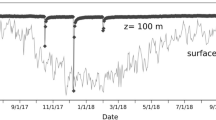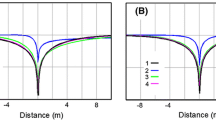Abstract
We present techniques to infer thermo-hydraulic parameters from the analysis of underground temperature data from boreholes. Two different cases are analyzed: thermal data from artesian wells and from boreholes drilled in unconfined aquifers. The former allow the assessment of the formation temperature gradient and the flow volume; the latter give estimates of the Darcy velocity and, consequently, allow the inference of the aquifer hydraulic conductivity. The analysis procedure consists in matching thermal logs with analytical models incorporating both heat and mass transfer. The thermo-hydraulic parameters are obtained from the coefficients of the advective models by means of the least-square fitting method. Examples of applications are given for a set of temperature logs from a geothermal area of northwestern Italy. Preliminarily, thermal gradients and the correction for the recent climate change were evaluated from thermal data of boreholes with no evidence of advection. The analysis of artesian boreholes gave high formation thermal gradients, in agreement with those obtained from boreholes with dominant conductive thermal regime. In boreholes drilled in permeable formations, the models predicting the temperature versus depth distribution resulted generally less sensitive to geological noise and fitted the field data better than the models based on the gradient analysis. If the shape of the thermal profile is taken into account as a qualitative descriptor of the type of flow, reliable estimates of the flow components can be obtained.







Similar content being viewed by others
References
Anderson MP (2005) Heat as a ground water tracer. Ground Water 43:951–968
Beck AE, Shen PY (1985) Temperature distribution in flowing liquid well. Geophysics 50:1113–1118
Bodri L, Cermak V (2005) Borehole temperature, climate change and the pre-observational surface air temperature mean: allowance for hydraulic conditions. Glob Planet Change 45:265–276
Chiozzi P, Pasquale V, Verdoya M (1998) Heat-flux anomaly in the Piedmont Tertiary Basin (NW Italy). In: Proceedings of the international conference the earth’s thermal field and related research methods. Moscow, 19–21 May 1998, pp 59–62
Domenico PA, Palciauskas VV (1973) Theoretical analysis of forced convective heat transfer in regional ground-water flow. Geol Soc Am Bull 84:3803–3814
Drury MJ, Jessop AM (1982) The effect of fluid filled fractures on the temperature profiles in a borehole. Geothermics 11:145–152
Drury MJ, Jessop AM, Lewis TJ (1984) The detection of groundwater flow by precise temperature measurements in boreholes. Geothermics 13:163–174
Ferguson G (2005) Comments on “Borehole temperature, climate change and the pre-observational surface air temperature mean: allowance for hydraulic conditions‘’. Glob Planet Change 48:313–314
Haenel R, Rybach L, Stegena L (1988) Fundamentals of geothermics. In: Haenel R, Rybach L, Stegena L (eds) Handbook of terrestrial heat-flow density determination. Kluwer Academic Publishers, Dordrecht, pp 9–57
Jessop AM (1987) Estimation of lateral water flow in an aquifer by thermal logging. Geothermics 16:117–126
Jessop AM (1990) Thermal geophysics. Elsevier, Amsterdam, pp 1–306
Lu N, Ge S (1996) Effect of horizontal heat and fluid flow on the vertical temperature distribution in a semiconfining layer. Water Resour Res 32:1449–1453
Mansure A, Reiter M (1979) A vertical groundwater movement correction for heat flow. J Geophys Res 84:3490–3496
Pasquale V, Balbi A (1986) Sul sistema geotermico di Acqui Terme. Atti Conv. Int. Medicina Termale e Abientale, Terme Castellammare di Stabia, pp 173–179
Pasquale V, Verdoya M (1990) Geothermal regime of the Po Basin, Italy. Mém. Soc. Géol. Fr., Paris, 156; Mém Soc. géol. suisse, Zürich, 1; Vol. spec. Soc. Geol. It., Roma 1:135–143
Pasquale V, Verdoya M, Chiozzi P, Bodri L, Bellani S (2005) Temperature signal in the underground for climate history reconstruction in Italy. Glob Planet Change 47:35–60
Pfister M, Rybach L (1996) High-resolution temperature logging in shallow drillholes for the determination of terrestrial heat flow: field examples and analysis. Tectonophysics 257:93–99
Pollack HN, Chapman DS (1993) Underground records of changing climate. Sci Am 268:44–50
Reiter M (2001) Using precision temperature logs to estimate horizontal and vertical groundwater flow components. Water Resour Res 37:663–674
Taniguchi M, Shimada J, Tanaka T, Kayane I, Sakura Y, Shimano S, Dapaah-Siakwan S, Kawashima S (1999) Disturbances of temperature–depth profiles due to surface climate-change and subsurface water flow: (1) an effect of linear increase in surface temperature caused by global warming and urbanization in Tokyo metropolitan area, Japan. Water Resour Res 35:1507–1517
Verdoya M, Pasquale V, Chiozzi P (1999) Hydrothermal circulation in the Tertiary Piedmont Basin (NW Italy). Bulletin Hydrogéol 17:123–134
Acknowledgments
We thank Dr G. Ghione for helping us to obtain permission to access the drill tests and to carry out temperature logging.
Author information
Authors and Affiliations
Corresponding author
Rights and permissions
About this article
Cite this article
Verdoya, M., Pasquale, V. & Chiozzi, P. Inferring hydro-geothermal parameters from advectively perturbed thermal logs. Int J Earth Sci (Geol Rundsch) 97, 333–344 (2008). https://doi.org/10.1007/s00531-007-0217-8
Received:
Accepted:
Published:
Issue Date:
DOI: https://doi.org/10.1007/s00531-007-0217-8




